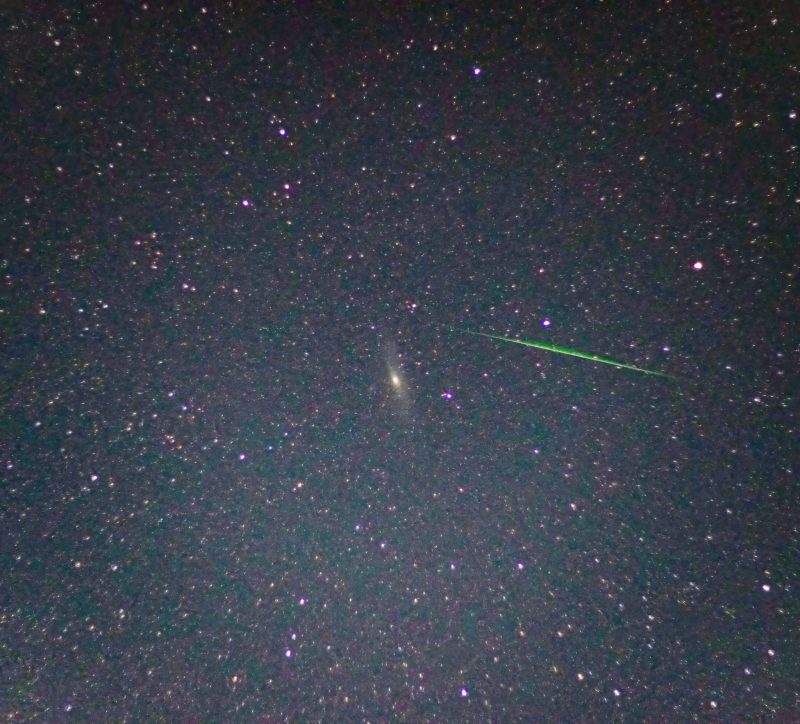Alpheratz belongs to Andromeda, but is part of the Great Square

The Great Square of Pegasus
There’s a large, easily recognizable pattern of four medium-bright stars – up in the sky on October and November evenings – that stargazers call the Great Square of Pegasus. However, one of these stars doesn’t formally belong to the constellation Pegasus. It’s Alpheratz, the brightest star in the constellation Andromeda. In fact, many people use this star to locate the Andromeda Galaxy in the night sky. While it appears as a single star to the unaided eye, Alpheratz is actually a tight double star system.
When can you see the star Alpheratz?
This star reaches its midnight culmination – its highest point in the sky at midnight – on October 9. So, it’s generally considered an autumn star for Northern Hemisphere observers. Yet you can see it in the summertime when it rises late at night. And by late winter, Alpheratz is setting with the sun.
At magnitude 2.06, Alpheratz isn’t as bright as the sky’s brightest stars. But you can spot it easily, except in very light-polluted areas.
Use Alpheratz to find the Andromeda Galaxy
The Andromeda galaxy, also known as M31, is the nearest large spiral galaxy to Earth. It’s the most distant thing we can see with the unaided eye, though you’ll need a dark sky to see it. Autumn is a good time to look.
People often find the Andromeda Galaxy by star-hopping from Alpheratz to two other stars in the constellation Andromeda, Mirach and Mu Andromedae. After you find those two stars, you can draw a line between them, and extend that line to find the galaxy, as shown in the chart below.

Science of Alpheratz
Alpheratz, at a relatively nearby distance of 97 light-years, is actually two stars orbiting about a common center of gravity every 97 days. We know it’s a binary stellar system because Alpheratz’s light spectrum shows two distinct sets of spectroscopic lines.
The larger of the pair is almost four times the sun’s mass, close to three times its size, and 200 times the sun’s total brightness. Its surface temperature is high, almost 14,000 Kelvin (approximately 27,400 Fahrenheit or 13,700 Celsius), more than twice that of our sun (that has a surface temperature of less than half that at 5,778 Kelvin). The spectral class of this star is B8p. The B8 represents a star that is much hotter and more massive than our sun. The “p” indicates that this is a “peculiar” star. It is peculiar in the sense that its spectrum reveals an unexpected amount of manganese and mercury.
The smaller companion is almost twice the sun’s mass and over 1 1/2 times its size. Its surface temperature is also hotter than the sun’s, at 8,500 Kelvin (14,840 F or 8,227 C), with a total brightness 10 times that of the sun.
Together, these two hot stars appear blue in the sky.
History and mythology
The most interesting part of this star’s history, from our modern perspective, is its assignment to the constellation Andromeda in the 1930s by the International Astronomical Union (IAU). Before that, Alpheratz was often referred to as Delta Pegasi, indicating that it was the fourth-brightest star in Pegasus. But some classical star charts showed it as part of Andromeda. So, it was considered part of the constellation Pegasus, or part of the constellation Andromeda, or, by some people, part of both constellations. Today, Alpheratz is officially Alpha Andromedae, the brightest star in Andromeda.
Early Arabian stargazers certainly saw Alpheratz as part of Pegasus, not Andromeda. We know this because the name Alpheratz derives from an Arabic phrase meaning the horse’s navel. This is an obvious reference to Pegasus the Flying Horse. Also, according to Richard Hinckley Allen, in his classic book “Star Names, Their Lore and Meaning,” Alpheratz was also called Sirrah, a derivation of another Arabic name, Surrat al Faras or the horse’s navel.

Bottom line: Alpheratz appears to our eyes as a single star but it is actually a close binary star system. Many stargazers use it to locate the Andromeda Galaxy.











